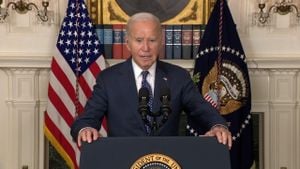Nangloi Jat MLA Raghuvinder Shokeen is set to take on the role of minister within the Delhi cabinet as part of the Aam Aadmi Party (AAP) government. This appointment, announced on Monday, follows the recent resignation of Kailash Gahlot, the party's prominent leader and former transport minister, who officially joined the Bharatiya Janata Party (BJP). Gahlot's departure is viewed as strategically significant as it alters the political dynamics within AAP, especially concerning Jat representation.
Shokeen, who has been associated with the AAP since its early days, was formally welcomed by senior party leaders, including former Deputy Chief Minister Manish Sisodia. Sisodia indicated Shokeen's selection was motivated by the need to maintain support from the Jat community, particularly rural voters, as AAP gears up for the upcoming elections.
During his introduction to the Cabinet, Shokeen expressed gratitude for the opportunity and underscored AAP's commitment to inclusivity, highlighting the party's efforts to integrate all sections of society. He noted, "...while the BJP has consistently worked against the Jat community, whether it was during the farmers’ protest, the issue with wrestlers, or the Haryana elections." His comments reflect a broader strategy by AAP to leverage socio-political sentiments among Jat voters, who have historically played a significant role in Delhi's politics.
Historically, the Jat community comprises around 4-5 percent of the electorate in Delhi. Political analysts suggest Shokeen’s ascendance might help sway undecided voters from rural pockets who are increasingly settling in unauthorized colonies across the city. His larger persona is expected to resonate well with these constituents, enhancing AAP's appeal and fostering political alliances.
Shokeen himself is not new to the political arena. Before aligning with AAP, he had represented the BJP, where he served both as councillor and as part of the Municipal Corporation of Delhi. His transition to AAP began during its formative years, reflecting his commitment to the party's principles. Notably, he has also made his mark as an educationist, running several primary schools, emphasizing his dedication to development and social welfare.
While the exact ministerial responsibilities await final confirmation, insiders suggest he is likely to oversee several key portfolios formerly held by Gahlot, including transport and women and child development, as well as supervise the implementation of the ambitious Mahila Samman Rashi scheme. This initiative, regarded as one of AAP's major electoral promises, aims to provide monthly financial assistance to eligible women aged 18 to 60.
The political shift surrounding Gahlot’s exit and Shokeen’s subsequent induction serves as more than just administrative restructuring; it is reflective of AAP's adaptive strategies ahead of the assembly polls. Gahlot's resignation was accompanied by claims of internal discord within AAP, entangled with allegations of corruption and ideological drift. He articulated his concerns publicly, stating his discontent with AAP’s direction, prompting many to speculate on the broader repercussions for the party.
Kailash Gahlot’s departure from AAP to the BJP highlights how political loyalties can shift dramatically. Gahlot emphasized his decision was free from external pressures, aiming to refute conjectures about coercion from central agencies investigating him. "This was not easy for me," he stated, reminiscing about his long-standing association with AAP since its inception alongside anti-corruption activist Anna Hazare.
His subsequent joining of the BJP marks both as personal evolution and party dynamics in flux; he criticized AAP’s confrontational stance toward the central government, advocating for collaboration on developmental initiatives instead of constant conflict as necessary for proper governance.
To bolster their position during this politically disruptive time, AAP also welcomed another Jat leader, former Congress MLA Sumesh Shokeen. His acceptance reflects AAP’s need to consolidate support from various factions within the Jat community. During Kejriwal’s remarks at the event, he highlighted the developmental strides made under AAP’s governance across rural areas, intending to amplify the party’s track record as they head toward the elections.
These recent developments not only showcase AAP’s strategic recalibrations to strengthen its political arsenal heading toward elections but also expose the shifting allegiances among prominent figures within Delhi's political sphere. With Gahlot's defection to the BJP, the stakes of upcoming parliamentary battles have undoubtedly increased.
Shokeen's role as minister will likely become pronounced as AAP continues to campaign for votes from rural constituencies. With his educational background and community-based initiatives, he might emerge as the voice of AAP among Jat voters, hoping to restore confidence and trust within this key demographic.
On the national front, as parties realign and strategize for the elections, Shokeen's presence is likely to influence electoral dynamics, particularly when it connects with disillusioned voters seeking representation and addressing local issues. The shifting narrative within Delhi's political cabinet reflects broader patterns of strength-based coalitions, aimed at mitigating the loss of political support and gaining traction among targeted voter groups.
Looking forward to the upcoming Assembly elections, analysts are closely monitoring AAP’s strategies and the potential impacts of Shokeen’s induction along with how Gahlot's move to the BJP might unsettle traditional voter bases.
Hence, as Shokeen steps forward this political churn will also test his ability to navigate the demands of his new role and the expectations from the party as it seeks to regroup and reinvigorate its appeal across diverse constituencies.



